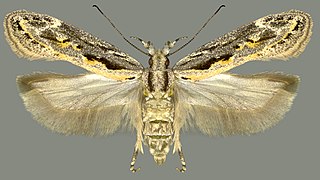
Hexadactilia trilobata is a moth of the family Pterophoridae described by Thomas Bainbrigge Fletcher in 1910. It is found in Australia in Queensland and New Guinea.
Cochylis fusca is a moth of the family Tortricidae. It is known from Mississippi, Illinois, Indiana, Missouri, Ohio and Pennsylvania.

Photedes captiuncula, the least minor, is a moth of the family Noctuidae. It is found throughout Europe, in Turkey, Armenia, Russia and much of temperate Asia.

Ornativalva plutelliformis is a moth of the family Gelechiidae. It was described by Staudinger in 1859. It is found from southern Europe and North Africa east to western Asia and China (Xinjiang).
Agonopterix lythrella is a moth in the family Depressariidae. It was described by Thomas de Grey in 1889. It is found in North America, where it has been recorded from Illinois, Maine, Maryland, Massachusetts, Michigan, Minnesota, New Brunswick, New Hampshire, New York, North Carolina, Nova Scotia, Ohio, Ontario and Saskatchewan.
Dichomeris helianthemi is a moth in the family Gelechiidae. It is found in Spain, France and Italy.
Dichomeris stratellus is a moth in the family Gelechiidae. It was described by Walsingham in 1897. It is found in the West Indies and Trinidad.
Helcystogramma daedalea is a moth in the family Gelechiidae. It was described by Walsingham in 1911. It is found in Mexico (Tabasco).
Filatima vaniae is a moth of the family Gelechiidae. It is found in North America, where it has been recorded from Utah and California.
Friseria infracta is a moth of the family Gelechiidae. It is found in Mexico (Guerrero).
Gelechia cuneifera is a moth of the family Gelechiidae. It is found in Mexico (Guerrero).
Commatica cryptina is a moth in the family Gelechiidae. It was described by Walsingham in 1911. It is found in Mexico (Tabasco).
Anacampsis conistica is a moth of the family Gelechiidae. It was described by Thomas de Grey, 6th Baron Walsingham, in 1910. It is found in Mexico.
Anacampsis rhabdodes is a moth of the family Gelechiidae. It was described by Thomas de Grey in 1910. It is found in Mexico (Tabasco).
Aristotelia pyrodercia is a moth of the family Gelechiidae. It was described by Walsingham in 1910. It is found in Mexico (Guerrero).
Protolychnis marginata is a moth in the family Lecithoceridae. It was described by Thomas de Grey in 1891. It is found in Gambia, Sudan and South Africa.

Ptilobola inornatella is a moth in the family Depressariidae, and the only species in the genus Ptilobola. It was described by Walsingham in 1891 and is found in Gambia and Ghana.
Trycherodes albifrons is a moth in the family Depressariidae. It was described by Lord Walsingham in 1912. It is found in Mexico, Guatemala and Panama.
Cerconota palliata is a moth in the family Depressariidae. It was described by Lord Walsingham in 1913. It is found in Guatemala.
Stenoma aterpes is a moth in the family Depressariidae. It was described by Lord Walsingham in 1913. It is found in Veracruz, Mexico.



